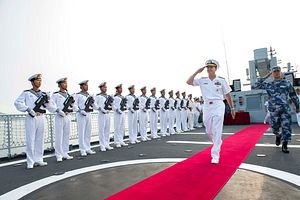Outgoing U.S. Chief of Naval Operations (CNO) Admiral Jon Greenert said that this Chinese counterpart, Admiral Wu Shengli, is “very interested in RIMPAC 2016,” Defense News reported. Greenert spoke with Wu for 90 minutes in a video call on Tuesday morning, then recounted parts of that conversation at a Washington, D.C. luncheon hosted by the Mine Warfare Association, the Surface Navy Association GWC, Association of Naval Aviation, and the Submarine League.
The Rim of the Pacific Exercise, or RIMPAC, is billed as the “world’s largest international maritime exercise” by the U.S. Navy, whose Pacific Fleet hosts the biennial exercise near Hawaii. China was invited to participate in RIMPAC for the first time in 2014, but some have already argued that the People’s Liberation Army Navy (PLAN) should not be invited back in 2016. The Diplomat’s own Ankit Panda argued in May that excluding China from RIMPAC 2016 “imposes… a very reasonable cost on China for its preference for unilateralism on the open seas.”
On Wednesday, Greenert told the audience that Wu “really wants to come to RIMPAC” in 2016. “He views the exercises as a positive step in dealing with challenges,” Greenert said. But he suggested that, ultimately, the decision would be made by higher-ups: “[Wu] wants that to work out. But we all have bosses.”
The U.S.-China military-to-military relationship is a complex one. On the one hand, the two militaries focus on each other as potential enemies. The U.S. Department of Defense is reportedly pushing for a stronger military response to China’s island-building in the South China Sea, including patrols within the 12 nautical mile zone of the artificial islands.
On the other hand, however, the mil-to-mil relationship has actually (if quietly) made positive strides over the last four years. Regular high-level military contacts between the two sides have increased and stabilized. Wu and Greenert’s conversation on Tuesday was itself a sign of increased communication between the U.S. and Chinese armed forces. The call was the second of a series of such video teleconference calls, which are scheduled to take place quarterly. The previous call was in late April.
Most notably, last year the U.S. and China agreed to a code of conduct that governs unexpected encounters between navies. The Code for Unplanned Encounters at Sea (CUES), spearheaded by a joint U.S.-Chinese effort, was signed by 21 Pacific countries in April 2014. CUES provides instructions for how sailors should respond when encountering another naval vessel in international waters. Both sides are interested in creating a similar code to govern unplanned aerial encounters.
Greenert said the CUES agreement was a positive step: “We think we’re on the right track.” In fact, he suggested expanding the agreement to cover coast guards as well – a crucial step, as China’s Coast Guard (not its navy) is largely responsible for patrolling disputed areas in the South and East China Seas. Greenert acknowledged that “the interactions that take place in the South China Sea are predominantly [with] Chinese Coast Guard ships… the gray hulls [the navies], we’re getting along just fine. You others, you ought to really get involved in this.”
Admiral Scott Swift, commander of the U.S. Pacific Fleet, also recently spoke of U.S. interest in pursuing a code of conduct with the Chinese Coast Guard. “Many of the encounters at sea that my naval ships have are as frequent with the Chinese Coast Guard — and other coast guards — as it is with the Chinese navy ships,” Swift said.
Greenert said U.S. Coast Guard Commandant Admiral Paul Zukunft has already presented a proposal regarding the creation of a CUES-like agreement to the Chinese Coast Guard. “We’ll see where that goes,” Greenert said.
Greenert himself will soon be stepping down, to be succeeded by Admiral John Richardson (previously the director of the Naval Nuclear Propulsion Program) next month. Greenert said that he had already introduced Richardson to Wu, and that Wu invited Richardson to visit China. Wu is “is big on mil-to-mil exchanges,” Greenert said, noting that the U.S. and Chinese navies had established a working relationship over the past few years.
Whether that relationship will extend to RIMPAC 2016 remains to be seen. The U.S. Congress is already growing antsy with deepening U.S.-China military relations without (some argue) anything positive to show for it. In December 2014, U.S. Representative Randy J. Forbes, chair of the House Armed Services Committee’s Seapower and Projection Forces Subcommittee, called for a review of U.S.-China military exchanges.
“[T]here is no indication that more engagement has helped to shape Beijing’s actions in a positive direction consistent with U.S. objectives,” Forbes wrote. “To the contrary, as we have increased our mil-mil engagement over the past two years, China’s actions have only turned more coercive.”

































